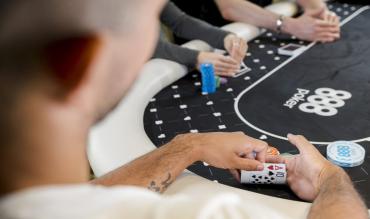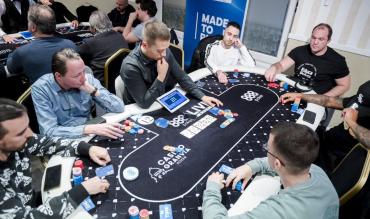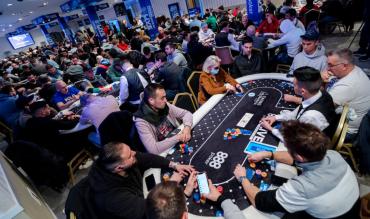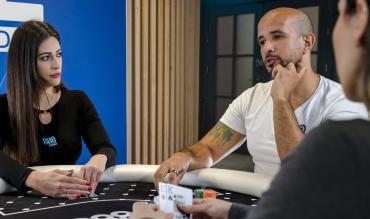In the world of gambling, few games can match the intrigue and complexity of poker. Whether played in smoke-filled casinos or online platforms, poker has captivated the minds of players for centuries. While mastering the mathematical and strategic aspects of the game is crucial, understanding the psychology behind it can give players a significant edge. For this, content sources - such as casino.org - can always help. But there is an incredible variety of options to better understand the subject. In this article, we will take a deep dive into the fascinating world of poker psychology, exploring the intricate interplay between the mind and the cards.
Mastering the Psychology of Poker: Resources and Insights
Success in the game requires more than just technical proficiency; it also requires the ability to read opponents, restrain one's emotions, and make deliberate decisions. While other well-known books like "Positive Poker: A Modern Psychological Approach to Mastering Your Mental Game" by Dr. Patricia Cardner and Jonathan Little, "The Mental Game of Poker" by Jared Tendler and Barry Carter, "Reading Poker Tells" by Zachary Elwood, and "Applications of No-Limit Hold'em" by Matthew Janda go deeper into the psychological aspects of the game, also book by Alan N. Schoonmaker', "The Psychology of Poker", offers helpful insights into players' mindsets.
These books provide methods and techniques for controlling feelings, spotting tells from rivals, and making the best choices, assisting players in bettering their overall play and understanding poker psychology. Understanding the psychological factors that influence players' behavior can provide invaluable insights into their strategies and enable one to exploit weaknesses effectively.
Other good sources are blogs, videos, poker podcasts and a very large list of content about the game that exists today to contribute more and more to the evolution in all its aspects.
Poker Psychology: Managing Tilt and Emotional Control
Tilt is a psychological phenomenon that is among the most important in poker. Tilt is a term used to describe a mental and emotional state of irritation that causes gamers to act irrationally. It frequently happens following a run of poor luck or substantial losses, forcing players to lose their cool and act rashly. Recognizing tilt in oneself and others is crucial, as exploiting tilted opponents can be highly profitable. Let's explore some steps below to better understand the context and try to avoid mental traps as much as possible.

Types of Tilt: Tilt can manifest in various forms, including steam tilt (anger-based tilt), frustration tilt (frustration-based tilt), and revenge tilt (a desire to recover losses). Each type can lead to impulsive actions and deviations from optimal strategies.
Recognizing Tilt: Self-awareness is essential in identifying when tilt begins to affect your play. Signs of tilt may include increased heart rate, irritability, impatience, and a change in decision-making patterns. Recognizing these signs allows you to take necessary steps to regain control. Like many things in life, the first step can be to understand yourself better and take a step back if necessary.
Tilt Avoidance Strategies: Proactively preventing tilt is often more effective than trying to recover from it. Strategies to avoid tilt include setting and adhering to stop-loss limits, taking breaks between sessions, and practicing proper bankroll management. Developing a resilient mindset and maintaining a positive attitude can also help mitigate tilt-inducing situations.
Tilt Recovery Techniques: If you find yourself on tilt, it's crucial to implement strategies to regain control. Taking a short break from the game, engaging in relaxation techniques such as deep breathing or meditation, and refocusing on the present moment can help restore clarity and composure. Analyzing hands objectively and seeking support from fellow players or poker communities can provide valuable perspectives and insights.
Bankroll Management: Proper bankroll management is an essential aspect of tilt prevention. Having a dedicated poker bankroll and adhering to proper bankroll management guidelines can help mitigate the emotional impact of losses and reduce the risk of entering tilt-inducing situations due to financial strain. It is crucial to be alert to this matter.
Mindset and Emotional Control: Developing a strong mental game and emotional control is fundamental to managing tilt. Cultivating resilience, accepting variance as an inherent part of the game, and maintaining a long-term perspective can help you detach emotionally from short-term outcomes and make rational decisions.
Seeking Professional Help: In severe cases where tilt negatively impacts a player's life beyond the poker table, seeking professional help from therapists or psychologists experienced in gambling-related issues can be beneficial. They can provide guidance and support in managing emotions, developing coping mechanisms, and addressing any underlying psychological factors contributing to tilt.
To overcome tilt, players must cultivate emotional resilience and develop strategies to manage their emotions effectively. By practicing mindfulness, maintaining a positive mindset, and employing techniques like deep breathing and visualization, players can regain control over their emotions and make rational decisions even in the face of adversity. Here are some key points to understand about bluffing in poker:
Mindset Poker: The Art of Bluffing and Deception
Bluffing is an integral part of poker, and understanding the psychological dynamics behind it can make or break a player's success. Bluffing involves creating a false narrative through deceptive actions and body language to convince opponents of a stronger hand than one possesses. The key to successful bluffing lies in reading opponents' reactions and adapting one's strategy accordingly. Here are some key points to understand about bluffing in poker:
Purpose of Bluffing: Bluffing serves multiple purposes in poker. It allows players to win pots without having the best hand, manipulate the perception of opponents, and create opportunities to extract value from stronger hands in future situations. Bluffing can also help balance one's range and prevent opponents from easily reading the strength of their hand.
Selecting the Right Spot: Successful bluffing requires choosing the right situations to execute the bluff. Factors to consider include the table dynamics, opponents' playing styles, position, and the board texture. Bluffing is more effective against tight and cautious players who are more likely to fold to aggression.
Reading Opponents: Bluffing is highly dependent on reading opponents' behaviors and betting patterns. Observing their tendencies, recognizing their level of aggression or passivity, and identifying potential weaknesses in their decision-making can help determine whether a bluff is likely to succeed.
Board Texture: The texture of the community cards is a crucial factor in bluffing. Bluffs are more effective when the board presents unfavorable possibilities for strong hands, such as a coordinated or paired board that limits the range of hands opponents can have. A well-timed bluff on a scary board can induce opponents to fold, even if they have a stronger hand.
Bet Sizing and Storytelling: Bluffing involves effective bet sizing and creating a narrative that supports the story being told. The size of the bluff should be appropriate to the pot size and the image the player has established at the table. A well-constructed storyline, backed by consistent actions and previous betting patterns, can make the bluff more believable and increase its chances of success.
Image and Table Dynamics: Building a strong table image as a solid and selective player can enhance the effectiveness of bluffing. If opponents perceive a player as tight and conservative, they are more likely to give credibility to their aggressive actions. Similarly, exploiting the dynamics and history between players can influence the success of a bluff, as opponents may be more inclined to fold to someone they perceive as a tougher opponent.
Bluff Frequency and Balance: Bluffing should be used strategically and balanced with value bets and strong hands. Overbluffing can make a player predictable and exploitable. It's essential to find the right balance and mix bluffing with value betting to maximize overall profitability.
Adjusting to Opponents' Reactions: Paying attention to opponents' reactions to bluffs is crucial. If an opponent calls or raises a bluff, it may indicate that they are not easily fooled and may require adjustments to the bluffing strategy. Conversely, if opponents frequently fold to bluffs, it may be an opportunity to bluff more frequently and exploit their tendencies.

Poker psychology teaches us that humans are naturally inclined to search for patterns and meaning in the behavior of others. By exploiting this tendency, skilled players can manipulate their opponents' perception and force them into making costly errors. It is a delicate dance of deception and observation, where a deep understanding of human psychology becomes a formidable weapon at the poker table.
Poker Psychology in Action: The Power of Reading Tells
In poker, a tell refers to a physical or behavioral cue that provides information about an opponent's hand. Whether it's a subtle twitch, a change in breathing pattern, or a nervous tic, experienced players learn to recognize and interpret tells to gain a significant advantage. However, decoding tells requires a keen eye and a thorough understanding of human behavior.
The aforementioned Alan Schoonmaker emphasizes the importance of observation in his book, highlighting that being attentive to opponents' actions can reveal vital clues about the strength or weakness of their hands. By observing and interpreting these signals, players can gain a significant advantage. Here are some common types of tells and tips for reading them:
Facial Expressions: Facial expressions can reveal a lot about a player's emotions and the strength of their hand. Twitches, microexpressions, or changes in facial coloration can indicate nervousness, excitement, or disappointment. For example, a player who suddenly tightens their lips or furrows their brow may be signaling uncertainty or a weak hand.
Body Language: Pay attention to opponents' posture, movements, and gestures. Leaning back may indicate relaxation or confidence, while leaning forward could suggest engagement or strength. Nervousness may manifest as fidgeting or restlessness. Sudden stillness or stiffness might be a sign of strength.
Bet Sizing: The size and timing of bets can offer valuable information about an opponent's hand. A large bet may indicate confidence and a strong hand, while a small bet might signify a weak hand or an attempt to induce a call. Quick, snap bets may suggest bluffing, as players often try to rush through a bluff to avoid being called.
Verbal Cues: Pay attention to what opponents say during a hand. In some cases, they may offer unintentional hints about the strength or weakness of their hand. For instance, a hesitant response or a change in tone when asked about their hand can reveal uncertainty. Players who confidently declare the strength of their hand might be trying to mislead or deceive.
Timing: The speed at which an opponent acts can be indicative of their hand strength. Quick decisions might indicate a strong hand, while hesitation or a long pause could imply a weaker hand or uncertainty. However, it's essential to note that timing tells can be intentionally manipulated, so consider other factors before making conclusions.
Bet Patterns: Observe the consistency or inconsistency of an opponent's betting patterns. Deviations from their usual betting style may suggest a change in hand strength. For example, a player who typically bets a certain amount with strong hands suddenly betting more or less might be trying to manipulate perceptions.
Mindset Poker: Confidence and Emotional Resilience
Confidence is a double-edged sword in poker. While a healthy dose of self-assuredness can intimidate opponents and tilt the odds in one's favor, overconfidence can lead to reckless play and substantial losses. The ability to strike a balance between confidence and self-control is crucial for long-term success.

Most of authors emphasize the need for self-awareness and discipline in poker. Understanding one's own strengths and weaknesses and having the self-control to stick to a well-defined strategy are fundamental principles of a winning mindset. By maintaining composure and resisting impulsive urges, players can make rational decisions and stay one step ahead of their opponents.
Decoding Poker Psychology: Key Takeaways for Success
Poker psychology is a captivating field that offers a wealth of insights into the intricacies of human behavior. By understanding the psychological factors that influence players' decisions, poker enthusiasts can sharpen their skills and gain an edge at the table. Many different kinds of content serve as an invaluable resource for those seeking a deeper understanding of the mindset required for success in the game. Whether it's managing emotions, reading opponents, or maintaining self-control, the psychological aspects of poker are as fascinating as they are essential.
One crucial aspect of poker psychology is managing emotions, as we said many times in this text. The ability to remain calm and composed in the face of both victories and defeats is essential. Emotions such as fear, greed, and frustration can cloud judgment and lead to impulsive decisions. Recognizing and controlling these emotions is vital for making rational choices and maintaining a long-term perspective in the game.
Another key element is reading opponents. Poker is not just a battle of cards; it's a battle of wits and perception. Understanding the subtle cues and tells that opponents give off can provide invaluable information about the strength of their hand. By carefully observing body language, bet sizing, and timing, skilled players can gain insights into their opponents' thought processes and use that information to their advantage. In addition to the many books that study the subject, online forums, poker blogs, and video tutorials also offer opportunities to learn from experienced players and engage in discussions about poker psychology. Several possible ways to find calm and control.
By the way, self-control is another critical aspect of poker psychology. The ability to resist impulses and stick to a well-thought-out strategy is crucial for long-term success. It's important to avoid falling into the trap of revenge tilt or the desire to recoup losses quickly. Maintaining discipline and adhering to sound bankroll management principles are key components of effective self-control.
So, the next time you sit down at the poker table, remember to decode the mindset and use psychology to your advantage. With a deeper understanding of poker psychology, you can elevate your game and achieve greater success in the fascinating world of poker.


